Verdict
The DJI Mavic 3 Pro doesn’t represent a giant leap forward from the ‘standard’ Mavic 3, but its three-camera payload makes it the best choice for any serious aerial photographer or videographer looking for a compact folding drone – provided they’re happy to deal with the restrictions brought about by its increased weight and stricter category.
Pros
- New 3x camera in addition to wide angle and 7x
- Long battery life
- Easy to fly
- Great range of safety features
Cons
- Seemingly too heavy to fly in the A1 category
Introduction
Despite having the same body as the 2021-released Mavic 3, the new DJI Mavic 3 Pro is a game-changer – the first folding drone to come with three cameras on board.
The Pro’s gimbal-mounted camera ‘pod’ features a wide-angle camera and a telephoto camera, both very similar to what we saw on the Mavic 3, but adds a medium telephoto camera to the party.
With a focal length equivalent to 70mm, this adds a whole new creative dimension to the drone – but does that make it worth the extra money (and weight) compared to the standard Mavic 3? After taking it out on a few flights, I have some thoughts.
Design
- 958g weight restricts where it can be flown
- Same general build as Mavic 3
- Folded size of 231.1 × 98 × 94mm
In terms of its design, the DJI Mavic 3 Pro is virtually identical to the previous Mavic 3 models released by DJI. Made of hard-wearing and discreet-looking dark grey plastic, it’s a quadcopter that folds down to a conveniently compact size.
Even if you don’t buy one of the Fly More bundles (which include an excellent carrying bag that houses the drone, controller, spare batteries and more), you’ll have few problems slipping this into a backpack or tote for a day of aerial shooting. DJI supplies a cover to keep the gimbal, camera and propellers protected while it’s folded and in transit.
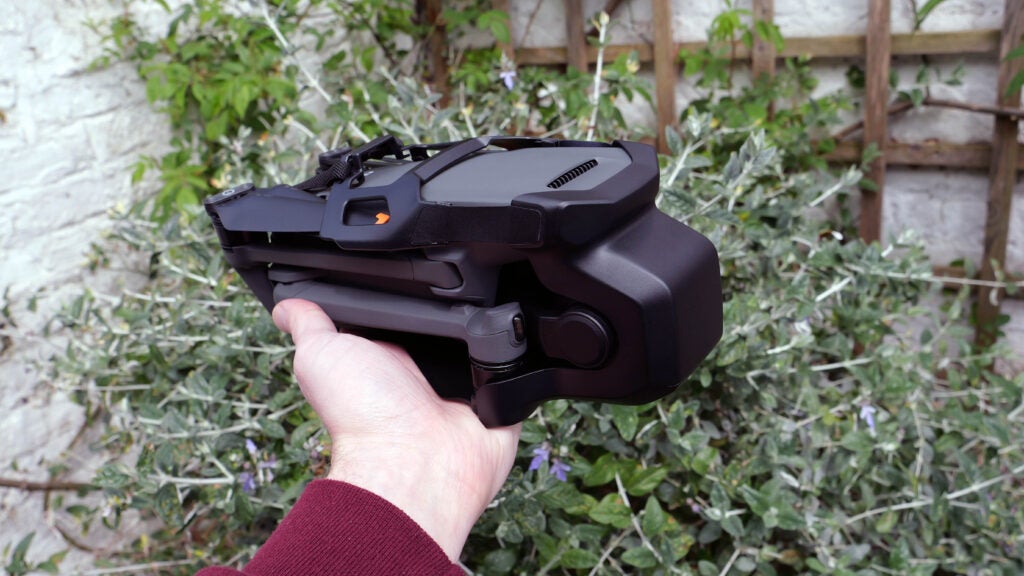
Like the Mavic 3 and Mavic 3 Classic, this is a heavier drone subject to lots of restrictions about where it can be flown – at least in the UK, where the CAA’s current rules are extremely limiting to any drone north of 250g in weight.
EU-based users may have an easier time flying the Mavic 3 Pro close to people and buildings (although being 958g it falls into the C2 category, making it more restricted than the sub-900g Mavic 3 and Mavic 3 Classic, which are C1 drones) but in the UK it must stay at least 50m horizontally from ‘uninvolved’ people (i.e. people who aren’t the pilot or the pilot’s companions) and at least 150m from buildings, which means urban flying is basically off the cards. If you’re looking for a high-quality drone to fly in town parks or similar, something like the DJI Mini 3 Pro is a better fit right now.
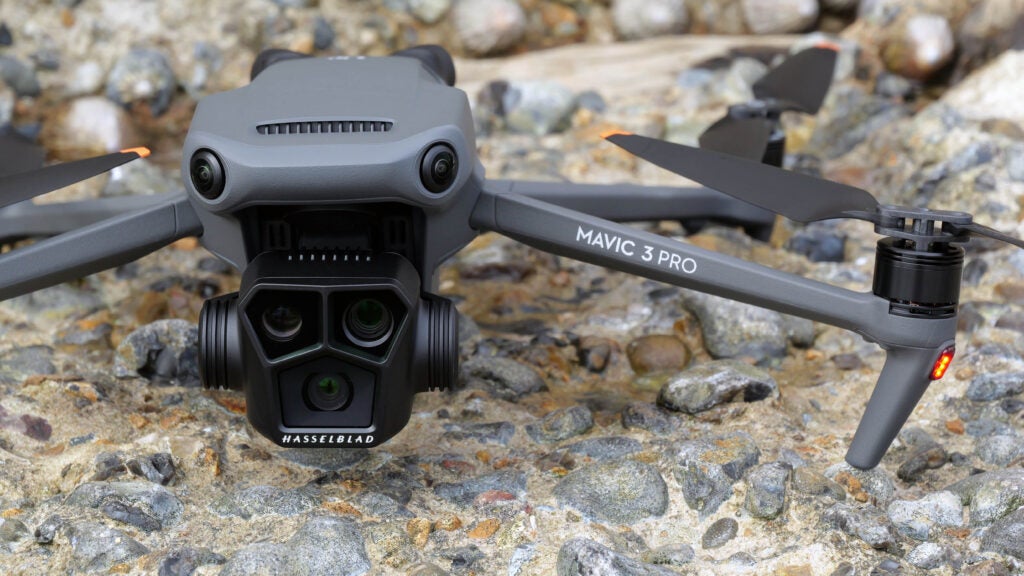
There’s 8GB of storage inside the regular Mavic 3 Pro (the Cine model has 1TB), which can be bolstered by a microSD card. Capacities up to 512GB are supported.
The Mavic 3 Pro is available with the RC or RC Pro controllers, both of which are excellent (the Pro has a better screen, however). They’re well built, compact and wirelessly connect to the drone quickly, and their internal batteries last for ages.
Performance
- Up to 43 minutes of flight time
- Omnidirectional object avoidance
- Up to 15km of video transmission range
The DJI Mavic 3 Pro flies in much the same way as the 2021 Mavic 3 – which is to say, it’s a brilliantly easy-to-use drone that does so much of the hard stuff for you.
Its extra weight means it does have slightly less flight time than the 46 minutes offered by the standard Mavic 3, but 43 minutes is still a long time to be in the air, and there’s nothing to stop you buying extra batteries if you need more.
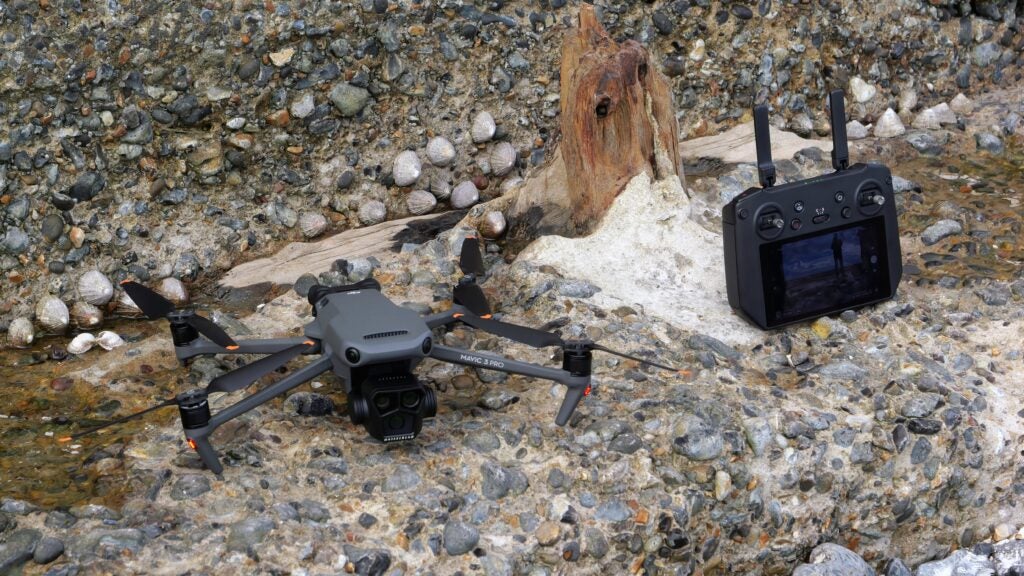
The drone takes off at the tap of a button and will return to its take-off spot and land automatically when requested (or if the battery is waning, or it loses its control signal). Once in the air, the twin-stick controls are simple and responsive, and the drone feels agile and zippy, particularly in the Sport mode where it can reach speeds of up to 21m/s (around 47mph). It’s also able to hover steadily in winds of up to 12m/s.
Aside from Sport, it can also fly in Normal and Cinema modes, both of which support omnidirectional object detection and the APAS 5.0 tech that’ll allow the drone to fly around obstacles automatically while tracking a moving subject. The object detection is superb and makes crashing the drone all but impossible – just be aware that Sport mode switches everything off and makes it much more susceptible to collisions.
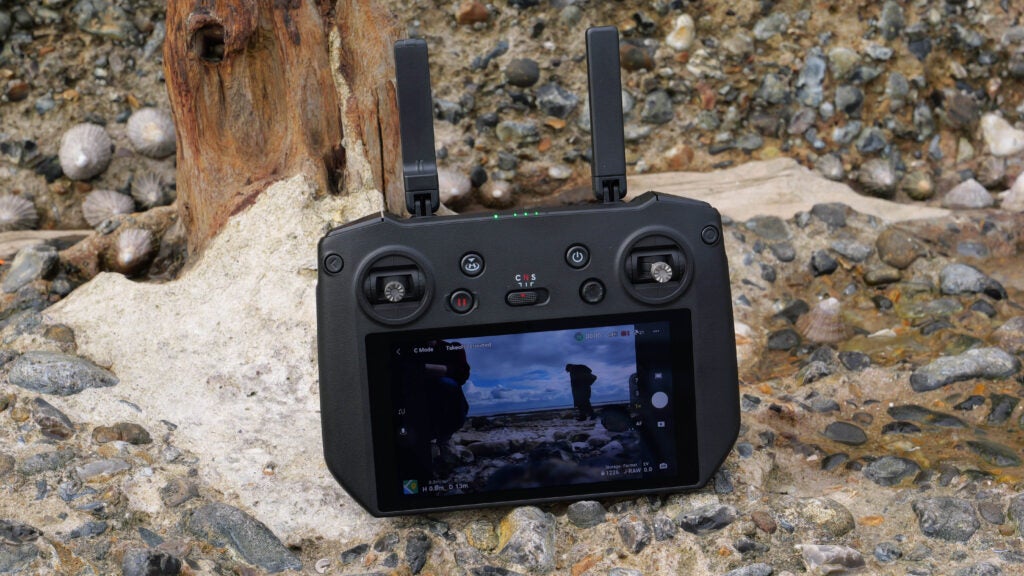
Video transmission is excellent too: you get a low-latency feed of up to 1080p quality from the drone’s camera to the controller screen, which helps with flying, and it works to a frankly astounding distance (15km theoretically, although you’d be breaking drone laws attempting even 10% of that distance). The point is: it’s very hard to lose the signal between controller and drone, and even if you do, you can expect the drone to return to its take-off point until it reacquires the connection.
Camera
- Hasselblad 20MP 4/3 CMOS main camera
- New 12MP/48MP medium telephoto camera
- Up to 5.1K video
The camera is the main reason to choose the DJI Mavic 3 Pro over existing Mavic 3 models, and it’s very impressive.
The main wide-angle Hasselblad camera (which offers a field of view equivalent to 24mm on a regular camera) is essentially unchanged from the Mavic 3, and it’s still the best here in terms of overall image quality: the sensor is a large 4/3 type, capable of 20MP stills and 5.1K/C4K/4K video with frame rates of up to 200fps.
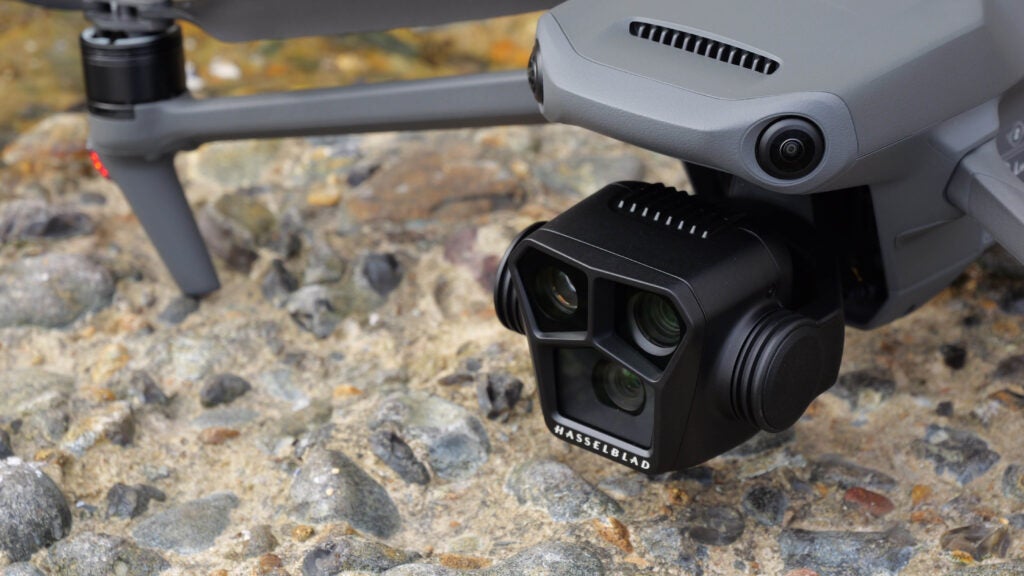
It can shoot in 10-bit 4:2:2 colour mode and features ‘flat’ profiles D-Log, D-Log M and HLG for easier post-production grading and correction. This is the camera to use in low-light situations, or when you want the most dynamic range possible, and I have zero complaints about its performance.
The DJI Mavic 3 Pro, like the Mavic 3, features a telephoto camera, but it’s slightly better here than on the 2021 model. The field of view is roughly the same (about 166mm) but the aperture is wider, so it’s a bit better in lower light situations. The sensor size is ½-inch, and it has a resolution of 12MP; users should note that it doesn’t shoot video in D-Log, D-Log M or HLG though – only the Normal colour mode, which isn’t ideal for post-production editing. It will record in up to 4K/60p quality, however.
Photo sample of DJI Mavic 3 Pro
Photo sample of DJI Mavic 3 Pro
Photo sample of DJI Mavic 3 Pro
Photo sample of DJI Mavic 3 Pro
The exciting development here is the addition of a third camera with a medium telephoto lens, equivalent to around 70mm. It can shoot 12MP/48MP native photos and 4K/60p video and supports HLG and D-Log M (but not regular D-Log), so it’s somewhere in the middle of the other two cameras in both focal length and quality.
The new 70mm perspective puts something else in this drone’s creative arsenal and offers a nice way to get clear images of a subject with a compressed viewpoint and ‘layered’ background, all without having to come too close. That makes it ideal for shooting wildlife or people without bothering them.
Latest deals
Should you buy it?
You want the best image quality in a folding drone:
Thanks to its triple-camera setup, the DJI Mavic 3 Pro surpasses the Mavic 3 as the best folding drone for aerial imaging.
You want a drone you can use everywhere:
Restrictions mean a sub-250g drone is preferable for general use. If you’re not a professional, the DJI Mini range is a better choice.
Final Thoughts
The DJI Mavic 3 Pro builds on the Mavic 3 and offers great creative freedom at a price that isn’t massively higher. It’s still a drone for professionals and enthusiasts first, however, and general everyday users should be wary of the restrictions it’s subject to.
For most people, a small, lightweight drone like the DJI Mini 3 Pro is a much more sensible choice right now – but if you’re willing to live with the legal limitations of the Mavic 3 Pro, there’s no better folding drone when it comes to image quality.
How we test
We thoroughly test every action camera we review. We’ll always tell you what we find and we never, ever, accept money to review a product.
FAQs
The DJI Mavic 3 Pro costs $2199/£1879 for the drone and DJI RC controller.
No, the Mavic 3 Pro is not waterproof, so DJI recommends avoiding flying it in the rain or above bodies of water.
Verdict
The DJI Mavic 3 Pro doesn’t represent a giant leap forward from the ‘standard’ Mavic 3, but its three-camera payload makes it the best choice for any serious aerial photographer or videographer looking for a compact folding drone – provided they’re happy to deal with the restrictions brought about by its increased weight and stricter category.
Pros
- New 3x camera in addition to wide angle and 7x
- Long battery life
- Easy to fly
- Great range of safety features
Cons
- Seemingly too heavy to fly in the A1 category
Introduction
Despite having the same body as the 2021-released Mavic 3, the new DJI Mavic 3 Pro is a game-changer – the first folding drone to come with three cameras on board.
The Pro’s gimbal-mounted camera ‘pod’ features a wide-angle camera and a telephoto camera, both very similar to what we saw on the Mavic 3, but adds a medium telephoto camera to the party.
With a focal length equivalent to 70mm, this adds a whole new creative dimension to the drone – but does that make it worth the extra money (and weight) compared to the standard Mavic 3? After taking it out on a few flights, I have some thoughts.
Design
- 958g weight restricts where it can be flown
- Same general build as Mavic 3
- Folded size of 231.1 × 98 × 94mm
In terms of its design, the DJI Mavic 3 Pro is virtually identical to the previous Mavic 3 models released by DJI. Made of hard-wearing and discreet-looking dark grey plastic, it’s a quadcopter that folds down to a conveniently compact size.
Even if you don’t buy one of the Fly More bundles (which include an excellent carrying bag that houses the drone, controller, spare batteries and more), you’ll have few problems slipping this into a backpack or tote for a day of aerial shooting. DJI supplies a cover to keep the gimbal, camera and propellers protected while it’s folded and in transit.

Like the Mavic 3 and Mavic 3 Classic, this is a heavier drone subject to lots of restrictions about where it can be flown – at least in the UK, where the CAA’s current rules are extremely limiting to any drone north of 250g in weight.
EU-based users may have an easier time flying the Mavic 3 Pro close to people and buildings (although being 958g it falls into the C2 category, making it more restricted than the sub-900g Mavic 3 and Mavic 3 Classic, which are C1 drones) but in the UK it must stay at least 50m horizontally from ‘uninvolved’ people (i.e. people who aren’t the pilot or the pilot’s companions) and at least 150m from buildings, which means urban flying is basically off the cards. If you’re looking for a high-quality drone to fly in town parks or similar, something like the DJI Mini 3 Pro is a better fit right now.

There’s 8GB of storage inside the regular Mavic 3 Pro (the Cine model has 1TB), which can be bolstered by a microSD card. Capacities up to 512GB are supported.
The Mavic 3 Pro is available with the RC or RC Pro controllers, both of which are excellent (the Pro has a better screen, however). They’re well built, compact and wirelessly connect to the drone quickly, and their internal batteries last for ages.
Performance
- Up to 43 minutes of flight time
- Omnidirectional object avoidance
- Up to 15km of video transmission range
The DJI Mavic 3 Pro flies in much the same way as the 2021 Mavic 3 – which is to say, it’s a brilliantly easy-to-use drone that does so much of the hard stuff for you.
Its extra weight means it does have slightly less flight time than the 46 minutes offered by the standard Mavic 3, but 43 minutes is still a long time to be in the air, and there’s nothing to stop you buying extra batteries if you need more.

The drone takes off at the tap of a button and will return to its take-off spot and land automatically when requested (or if the battery is waning, or it loses its control signal). Once in the air, the twin-stick controls are simple and responsive, and the drone feels agile and zippy, particularly in the Sport mode where it can reach speeds of up to 21m/s (around 47mph). It’s also able to hover steadily in winds of up to 12m/s.
Aside from Sport, it can also fly in Normal and Cinema modes, both of which support omnidirectional object detection and the APAS 5.0 tech that’ll allow the drone to fly around obstacles automatically while tracking a moving subject. The object detection is superb and makes crashing the drone all but impossible – just be aware that Sport mode switches everything off and makes it much more susceptible to collisions.

Video transmission is excellent too: you get a low-latency feed of up to 1080p quality from the drone’s camera to the controller screen, which helps with flying, and it works to a frankly astounding distance (15km theoretically, although you’d be breaking drone laws attempting even 10% of that distance). The point is: it’s very hard to lose the signal between controller and drone, and even if you do, you can expect the drone to return to its take-off point until it reacquires the connection.
Camera
- Hasselblad 20MP 4/3 CMOS main camera
- New 12MP/48MP medium telephoto camera
- Up to 5.1K video
The camera is the main reason to choose the DJI Mavic 3 Pro over existing Mavic 3 models, and it’s very impressive.
The main wide-angle Hasselblad camera (which offers a field of view equivalent to 24mm on a regular camera) is essentially unchanged from the Mavic 3, and it’s still the best here in terms of overall image quality: the sensor is a large 4/3 type, capable of 20MP stills and 5.1K/C4K/4K video with frame rates of up to 200fps.

It can shoot in 10-bit 4:2:2 colour mode and features ‘flat’ profiles D-Log, D-Log M and HLG for easier post-production grading and correction. This is the camera to use in low-light situations, or when you want the most dynamic range possible, and I have zero complaints about its performance.
The DJI Mavic 3 Pro, like the Mavic 3, features a telephoto camera, but it’s slightly better here than on the 2021 model. The field of view is roughly the same (about 166mm) but the aperture is wider, so it’s a bit better in lower light situations. The sensor size is ½-inch, and it has a resolution of 12MP; users should note that it doesn’t shoot video in D-Log, D-Log M or HLG though – only the Normal colour mode, which isn’t ideal for post-production editing. It will record in up to 4K/60p quality, however.
Photo sample of DJI Mavic 3 Pro
Photo sample of DJI Mavic 3 Pro
Photo sample of DJI Mavic 3 Pro
Photo sample of DJI Mavic 3 Pro
The exciting development here is the addition of a third camera with a medium telephoto lens, equivalent to around 70mm. It can shoot 12MP/48MP native photos and 4K/60p video and supports HLG and D-Log M (but not regular D-Log), so it’s somewhere in the middle of the other two cameras in both focal length and quality.
The new 70mm perspective puts something else in this drone’s creative arsenal and offers a nice way to get clear images of a subject with a compressed viewpoint and ‘layered’ background, all without having to come too close. That makes it ideal for shooting wildlife or people without bothering them.
Latest deals
Should you buy it?
You want the best image quality in a folding drone:
Thanks to its triple-camera setup, the DJI Mavic 3 Pro surpasses the Mavic 3 as the best folding drone for aerial imaging.
You want a drone you can use everywhere:
Restrictions mean a sub-250g drone is preferable for general use. If you’re not a professional, the DJI Mini range is a better choice.
Final Thoughts
The DJI Mavic 3 Pro builds on the Mavic 3 and offers great creative freedom at a price that isn’t massively higher. It’s still a drone for professionals and enthusiasts first, however, and general everyday users should be wary of the restrictions it’s subject to.
For most people, a small, lightweight drone like the DJI Mini 3 Pro is a much more sensible choice right now – but if you’re willing to live with the legal limitations of the Mavic 3 Pro, there’s no better folding drone when it comes to image quality.
How we test
We thoroughly test every action camera we review. We’ll always tell you what we find and we never, ever, accept money to review a product.
FAQs
The DJI Mavic 3 Pro costs $2199/£1879 for the drone and DJI RC controller.
No, the Mavic 3 Pro is not waterproof, so DJI recommends avoiding flying it in the rain or above bodies of water.

























